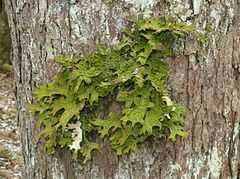Lobaria
| Lobaria | |
|---|---|
 | |
| Lobaria pulmonaria | |
| Scientific classification | |
| Kingdom: | Fungi |
| Division: | Ascomycota |
| Class: | Lecanoromycetes |
| Order: | Peltigerales |
| Family: | Lobariaceae |
| Genus: | Lobaria (Schreb.) Hoffm. |
| Species | |
|
many, including: | |
Lobaria is a genus of lichens commonly known as "lungwort" or "lung moss" as their physical shape somewhat resembles a lung. Lobaria species are unusual in that they have a three-part symbiosis, containing a fungus, an alga and a cyanobacterium, the presence of the cyanobacterium allowing nitrogen fixation.
Their sensitivity to toxins makes them an excellent indicator of ecosystem health, and they are often found in ecological climax communities such as the old growth forests of northwestern North America.
Under the doctrine of signatures, Lobaria pulmonaria is sometimes used to treat respiratory infections, although there is no peer-reviewed data to support the efficacy of this treatment.
Lobaria pulmonaria has been found to have moderate anti-inflammatory effects, and strong anti-ulcerative effects in rats.[1]
References
- Miadlikowska, Jolanta et al. (2006) New insights into classification and evolution of the Lecanoromycetes (Pezizomycotina, Ascomycota) from phylogenetic analyses of three ribosomal RNA- and two protein-coding genes, Mycologia, 98 (6): 1088-1103.
External links
- Links to photos of various Lobaria spp
- Monograph on herbal uses of lobaria
- A private naturalist's discussion of Lobaria
- Cross-section showing all three symbionts